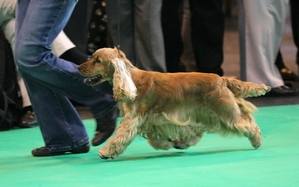Health and welbeing of our Cockers
 |
Health and welbeing is paramount - here, Blondie shows her excellent conformation, holding her topline on the move and excellent extension - lovely !
Breeders should be conscious of the health and wellbeing of all stock. The Cocker is generally a healthy breed with no major problems. However there are some hereditary conditions which do affect our breed. Reputable breeders conduct an on-going programme of health testing.
DNA Testing : With these tests breeders are able make advised decisions about their breeding programme and establish the health status of their stock with regard to the following conditions - PRA; FN; AMS and AON:
EYE CONDITIONS: for which annual testing is carried out by specialist eye panellists under the Kennel Club/British Veterinary Association schemes, include PRA (Progressive Retinal Atrophy) - and Glaucoma (Gonioscopy) Graded every three years;
Familial Nephropathy (FN) or shrunken kidney is an inherited condition that affects the breed and leads to kidney failure, typically, between the ages of 6 and 24 months.
Acral Mutilation Syndrome (AMS). Affecting dogs from 3 to 12 months, will start with lesions on distal extremities caused by self-mutilation; loss of sensitivity to pain on distal limbs may cause a tendency to lick or bite their own pads which could result in an auto-amputation of claws, digits and footpads in severe case – there will be no sign of limping:
To date this condition has appeared in Working Cockers.
Adult Onset Neuropathy (AON). A progressive weakness due to a neuropathy has been recognized as an autosomal recessive, hereditary disorder in English Cocker Spaniels by the research team at the University of Missouri Animal Molecular Genetic Lab. Clinical signs typically begin between 7.5 and 9 years of age and consist first of an uncoordinated gait or wobbling in the hind limbs. The stance in the hind limbs is wide-base and the hocks will drop lower to the ground. The weakness eventually progresses to also involve the front limbs. When dogs become non-ambulatory in all limbs, difficulty in swallowing also becomes apparent. The neurologic signs seem to progress gradually over 3 to 4 years and more slowly than those of degenerative myelopathy.
HIP Scoring: Hip Dysplasia (abnormal development of the hip joint) is generally associated with larger breeds, although it can be found in any breed; cockers are not considered to be greatly affected, however the condition continues to be monitored. It can cause lameness or produce no noticeable symptoms.
The Hip Score is carried out by x-ray of both hip joints, each of which are given a score between 0 and 106 (53 for each hip). Relatively small numbers of cockers in the UK are hip-scored todate. The current breed average score is 14.
More detailed information may be obtained from The Kennel Club; also The Cocker Spaniel Breed Council website – www.cockerspaniel-ino.org.uk/health.htm; The Cocker Spaniel Club site – www.thecockerspanielclub.co.uk/health.htm .
Click HERE to return to top of page